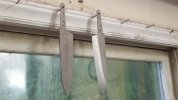I found that stropping alone with green compound is typically enough if you don't let the edge get really dull. If the edge needs more work, I've been using a Shapton Kuromaku 1000 grit and finish on a strop. I also have a King 6000grit stone but don't use it much.
You might want to add some 2 micron diamond powder or paste.
@Oyster asked about the negative effects of using only green compound on D3V, and Nathan replied.
Oyster
Question for the expert sharpeners:
3V is generally grouped with the carbon steels and, like those, responds very well to stropping using regular compounds. At least initially.
My understanding is that the regular compounds (i.e. black and green) will remove the softer material but aren’t able to cut the vanadium carbides. The result is that you get a sharp edge at first but, with continued stropping, the softer material is slowly taken away and the (uncut) vanadium carbides remain without anything to hold them in the matrix so that they easily tear out, quickly leaving a dull edge. For this reason, I remember reading somewhere that diamond paste or other similar compound is better to use as it is able to also cut the hard vanadium carbides - thus avoiding quick/sudden edge degradation as described.
Experiences/thoughts?
Nathan the Machinist
I blend some 2 micron diamond powder into my green stropping shmoo to address that issue
real stropping compound (look at straight razor sites) works better than buffing compound block.
You don't want to build it up too thick, but it does glaze and dull like any abrasive, so I refresh it with a thinned out mixture made with compound and alcohol to mix it up with a finger tip and get some fresh particles onto the surface without building it up.



